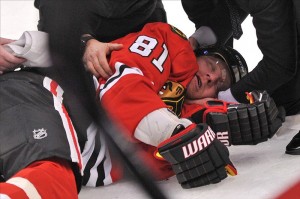Within the span of just four months in 2011, the hockey world mourned the loss of three players. The deaths of Rick Rypien and Wade Belak were ruled as suicides while the death of Derek Boogaard resulted from an alcohol and prescription pain medication overdose. All three of these men played the role of enforcer on the various teams for which they played. As enforcer, they regularly dealt and received blows, often to the head.
Although no direct link can be made between head injuries and these three untimely deaths, chronic traumatic encephalopathy (CTE) may have been a factor. CTE is a progressive disease caused by repeated trauma to the head. Sufferers of CTE may present intense depression, dementia and bizarre behaviors, all of which have been linked to suicide. Even in cases where concussions do not lead to CTE, head trauma may play a factor in mental illness. The prevalence of depression in the general population is no higher than 10 percent yet it reaches 40 percent among head trauma patients.
Given the risk that head trauma may play in mental illness and even suicide, the NHL has taken measures to protect players. In fact, rule changes to promote safety have a long history in the NHL. For example, in 1979, the NHL made helmets mandatory for all incoming players. Quality hockey equipment is an important line of defense. Players at all levels should be sure to wear quality protective gear, such as Brian’s equipment for goalies.

More recent safety measures implemented by the NHL include the revamping of the checking rules put in place before the 2011 season. All checks targeting the head were made illegal when previously, only checks from the lateral or blind side were illegal. The wording of the boarding rule was also changed to provide additional protection to the player being hit.
In the annual meeting of general managers in March, 2012, several proposals for new rules were put on the table. There was substantial support for implementing the hybrid icing rule in which icings can be whistled dead using the faceoff circle as a marker to avoid players crashing into the boards when racing to touch up. Numerous players have suffered serious injuries during touch-icing incidents.
Other measures discussed included putting the center line back in to slow the pace of the game, removing the trapezoid area where the goalie can play the puck behind the goal line, and the elimination of defensive zone hand passes. Brendan Shanahan, NHL Director of Player Safety, has also engaged in discussions with equipment manufacturers to improve the protection offered hockey equipment such as shoulder and elbow pads.
Great article, Bruce. This knowledge can hopefully help save someone else’s life.
Bruce,
Thanks for sharing this. The NHL has made progress in this
area. The problem players and the league encounter is the conflicted nature of
hockey fans: We crave big hits and blood and guts playoff performances. But
man, we really have to do something about all these dirty hits and concussions.
Do we not see the dichotomy of these desires? No? We punish
and promote fighting? No wonder players, officials, GMs, and NHL management
don’t seem to be making sufficient progress. Part of the problem is we–fans,
players, dare I say hockey writers, don’t know what we want.
Surely we can agree that today’s players are bigger, faster,
and brawnier.
For sure, we can agree–I trust–that we’re uncomfortable
with the results: CTE, concussions, fatigue, memory loss, etc. Google NHL +
memory loss and you’ll find stories not only about the enforcers you’ve mentioned,
but also about players who weren’t known for dropping the gloves. For example,
Ron Duguay would love to write a memoir, but he can’t remember enough detail to
do so. Other lesser-known players are suffering the same symptoms.
Can we concur that the risk of players incurring these
long-lasting symptoms is rising? Perhaps.
The NHL says it needs to do more study before drawing
conclusions. I’m all for more education after the fact. I’m glad the NHL is
addressing player safety.
It’s not enough.
Until we–fans, writers, players, officials, all of us who
love the game–dedicate ourselves to digging deeper into the risks and rewards,
the psychology and sociology, and all factors that contribute to our conflicted
hockey mindset, any progress the NHL makes may be too later for too many
players.
We won’t, I believe, derive better answers until we ask
better questions.
Bruce, thanks for the opportunity to continue discussion on
this topic.
Jim – this is just a teaser. We’ll be posting a much longer and more serious article on injuries and equipment on our spinoff site Overtime. You can follow THW_overtime on Twitter for new on its publication. Should be by mid-week. I promise you it will be quite detailed and thorough. Overtime (https://test.thehockeywriters.com/overtime) is where we showcase quality long form journalism.